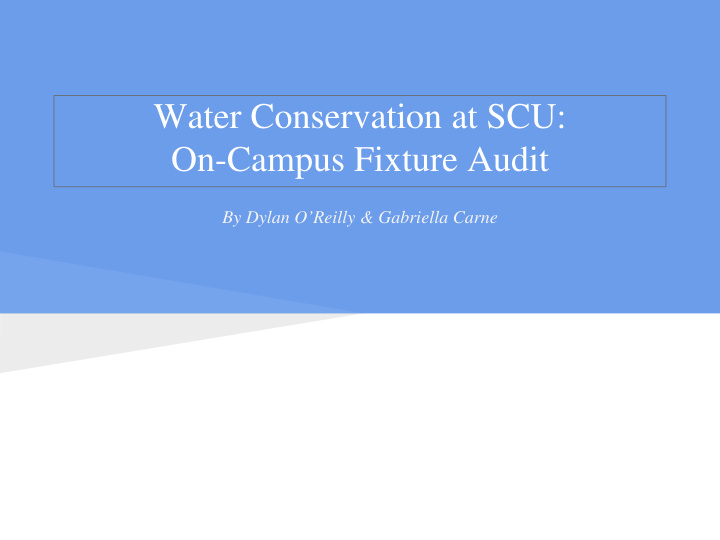



Water Conservation at SCU: On-Campus Fixture Audit By Dylan O’Reilly & Gabriella Carne
California, including Santa Clara and the Bay Area, is currently in the midst of one of the worst droughts on record. In order to remediate the effects of the drought and to preserve water in case of future droughts, it is imperative that SCU do all it can to limit its potable water usage.
Objectives “Continue to reduce potable water usage in campus buildings”
Gather a better understanding on Santa Clara’s on- campus water usage
Uncover areas of fixture weaknesses on campus
Propose suggestions to Facilities to better improve on-campus water efficiency
Met with Facilities & targeted older and at- risk buildings
Met with Facilities & Gathered assumed targeted older and at- gallons per minute risk buildings (GPM) data from initial sites
Met with Facilities & Gathered assumed Gathered actual targeted older and at- gallons per minute GPM data from risk buildings (GPM) data from initial sites initial sites
Met with Facilities & Gathered assumed Gathered actual targeted older and at- gallons per minute GPM data from risk buildings (GPM) data from initial sites initial sites Calculated found GPM
Met with Facilities & Gathered assumed Gathered actual targeted older and at- gallons per minute GPM data from risk buildings (GPM) data from initial sites initial sites Conducted Calculated found “mini audits” on GPM additional on-campus buildings
Met with Facilities & Gathered assumed Gathered actual targeted older and at- gallons per minute GPM data from risk buildings (GPM) data from initial sites initial sites Conducted Calculated found Calculated new “mini audits” on GPM GPM data additional on-campus buildings
Met with Facilities & Gathered assumed Gathered actual targeted older and at- gallons per minute GPM data from risk buildings (GPM) data from initial sites initial sites Conducted Calculated found Calculated new “mini audits” on GPM GPM data additional on-campus buildings Target areas of weakness and establish recommendations for future SLURP projects & Facilities action
Results Results
Results What we found: 88% of aerators work at or below marked GPM.
Final Calculations Assumptions ❏ Each person washes their hands at least twice a day ❏ Each person washes their hands for approximately 20 seconds ❏ Approximately 34% of aerators are 1.5, 34% are 2.2, and 27% are 2.0 based on full scale auditing of certain academic and residential buildings
Final Findings How Much Can We Save? 5,800 gallons/ day 1.5 million gallons/ year That’s 2% of SCU’s Potable Water Use! What else can we do?
Recommendations ● Future SLURP projects looking at the following: Resident Hall shower fixtures and toilets o The behavior behind a SCU student’s water consumption o ● Facilities: Target areas of fixture weakness by installing 1.0 GPM fixtures o Where to focus: ● Sanfilippo, Kenna, Alumni Science o Other residence halls and personal sinks in rooms o ● Gather student support for installation with campus campaigning
Acknowledgements We would like to personally thank our professors Stephanie Hughes and Hari Mix for their encouragement and collaboration. Thank you to Lindsey Kalkbrenner, Cara Uy, and Blair Libby at the Sustainability Center for the inspiration for our project. Finally, thank you to Andy Hernandez of Facilities for being a source of information and support for the past two quarters.
Recommend
More recommend